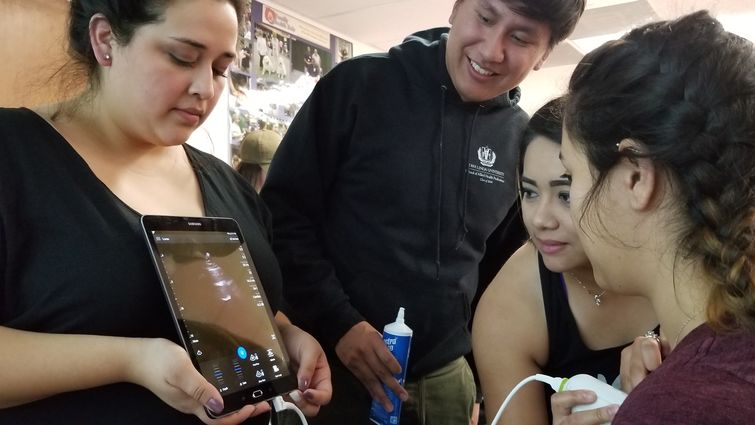
Loma Linda University School of Allied Health Professions Respiratory Care program is incorporating lung ultrasound training and protocols, the only such bachelor’s degree program in California to do so.
Lung ultrasound is a non-invasive imaging test to look into the lungs in real-time at the patient’s bedside. In the evaluation of several acute conditions, lung ultrasound is more accurate than a portable chest x-ray and equal in accuracy to a computerized tomography scan or CT scan. The technology is used to enhance the diagnostic process by providing the clinician a rapid and visual look into the lungs. From there, respiratory care practitioners (respiratory therapists) and physicians have a more decisive path for treatment.
“This non-invasive technology provides a swift and accurate assessment of the lungs with the potential to positively affect patient care,” said Richard Nelson, MD, MSRC, RRT-NPS, RCP, program director of the bachelor’s in science in respiratory care program at the school. “While it can’t replace every kind of scan, it can decrease wait time for assessments and in some cases can decrease scan frequency, thereby potentially reducing harmful radiation exposure.”
Traditionally, lung ultrasounds have been performed by physicians at emergency departments, producing positive outcomes for patients experiencing cardiorespiratory emergencies such as asthma, acute bronchitis, pneumonia, or constructive obstructive pulmonary disease (COPD). Nelson trained in France under Dr. Daniel Lichtenstein, the pioneer of lung ultrasound. The common use of lung ultrasounds in emergency departments across the country led Nelson to include the advanced technology in respiratory therapy student training, which was the first lung ultrasound certification program for respiratory care practitioners in the United States.
Respiratory care practitioners trained in lung ultrasound are more efficient in critical care patient assessment, Nelson said. The practitioner can examine if a patient’s symptoms change and can rapidly assess if the lungs have become wet, dry, or consolidated and if the lung wall is sliding. An ultrasound exam can also better reveal if a patient’s shortness of breath is pulmonary edema or pneumonia, or if a cause is pneumothorax or asthma-related. The practitioner can then follow a protocol to make a suggestion to the physician.
The university implemented the program three years ago and was the first to create a lung ultrasound assessment protocol to be performed by licensed respiratory care practitioners.
The program has also initiated the first interdisciplinary study involving physicians and respiratory care practitioners to clinically evaluate lung ultrasound. The study’s objective is to examine concurrency between a student’s or practitioner’s assessment and a physician’s assessment of lung ultrasound findings.
“Studies on lung ultrasound used by physicians have shown that the use of the technology has had a significant impact on the decision-making and therapeutic management of patients and how quickly care is administered,” Nelson said.
The respiratory care program at the Loma Linda University School of Allied Health Professions was recently re-accredited by the Commission on Accreditation for Respiratory Care receiving the maximum 10-year accreditation and received the Distinguished Registered Respiratory Therapist Credentialing Success award for meeting elite program standards. In addition to these successes for the program, Nelson said the past three years of graduates have also experienced full employment, all finding work within three months of graduation.
For Nelson, adding lung ultrasound training is just one step in continuing the university’s more than 40 years of excellence in respiratory care. “Our goal for the program is to continue building on that legacy of leadership in the profession by seeking out and incorporating advanced training and assessment techniques that make a positive difference in patient care.”
For more information on the bachelor’s in science in respiratory care program at Loma Linda University, visit the program's website or contact 909-558-4599.
